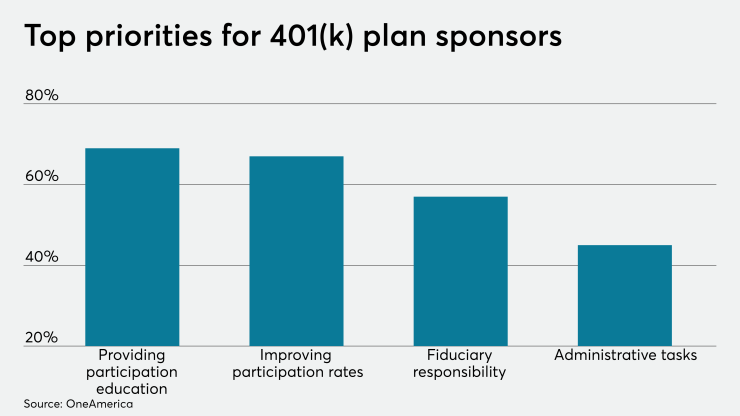The COVID-19 crisis has created a situation where tens of millions of American workers are in danger of seeing their retirement savings depleted. In addition to the awful death toll, the outbreak has led to extreme disruption in daily life, financial markets, and the economy — especially employment. As of May 28, more than 40 million Americans filed claims for unemployment benefits in the previous 10 weeks. This deadly combination of 1) levels of unemployment not seen since the Great Depression, 2) a significant market downturn, and 3) the ongoing plan-to-plan portability gap, has serious implications for these Americans’ retirement outcomes.
Processing Content
On top of that, the companies forced to lay off employees in recent weeks could be vulnerable to liability since, as fiduciaries, they have a duty to act in the best interests of participants. Years from now, terminated employees who discover they have less income in retirement due to an automatic rollover or automatic cash-out, which they weren’t aware of, could choose to sue.
Consider the circumstances
Americans subject to layoffs due to the pandemic likely won’t be able to find new employment until lockdowns and other restrictions subside, and the economic recovery begins. For now, the retirement savings they have accumulated may remain in their former employers’ defined contribution plans, unless cashed out to pay for emergency or basic living expenses. Recent market losses will likely have caused 401(k) account balances for many active and terminated participants to decrease.
However, if a terminated participant’s 401(k) balance is less than $5,000, their former employer has the right to automatically roll their savings into a safe-harbor IRA. Under the Economic Growth and Tax Relief Reconciliation Act of 2001, the only default investment choices permitted for safe-harbor IRA accountholders are principal-protected products. The historically low interest rates of the past decade led these investment options to yield meager returns long before “social distancing” became part of our national lexicon. Now, with interest rates set at zero, most of these products are yielding 0.001% annually, or $1 for every $1,000 invested. Meanwhile, if a terminated participant’s 401(k) balance declines to below $1,000, their former employer can automatically cash out the entire sum.
In all cases, sponsors must send notices about automatic cash-outs to terminated participants, but if a participant’s address isn’t current in the files of the plan recordkeeper, they won’t receive the check, leading to an uncashed-check headache for the plan sponsor, and an inability for the participant to take control of those retirement savings.
Fortunately for plan participants and sponsors alike, a technology solution designed to prevent this scenario has been live for nearly three years.
Auto portability has put an infrastructure in place that enables sponsors and their recordkeepers to seamlessly move a terminated participant’s 401(k) savings to an active account in their current employer’s plan at the point of job-change. The auto portability service is underpinned by “locate” technology and a “match” algorithm which work in tandem to identify inactive accounts, find the accountholder’s active account, and begin the process of consolidating the inactive account balances into the participant’s active account in their current employer’s plan.
Plan sponsors can elect an auto portability configuration that allows the balance to remain in the prior-employer plan until the participant’s new-employer plan is found. This means that a laid-off participant who may take many months to find a new job will have their retirement balance stay where it is until the participant is enrolled in a new plan, avoiding the messy problems with forced cash-outs or safe-harbor IRAs.
The automation of plan-to-plan asset portability helps sponsors and recordkeepers track down lost ex-employees with out-of-date addresses, and prevent recently terminated employees from going missing in the first place. Once laid-off employees find new jobs, auto portability can facilitate the efficient consolidation of their 401(k) account balances into their new employers’ plans.
Encourage participants to just say ‘No’ to cash-outs
Just as importantly, auto portability can help participants avoid the destructive decision to cash out their 401(k) savings. Without assistance, participants often find the process of rolling their 401(k) accounts from their previous employer’s plan into their current employer’s plan to be complex, costly, and time-consuming — leading too many workers to perceive cashing out as a far easier option.
Furthermore, the jobless-claim filers who have been laid off by employers during the COVID-19 pandemic may be tempted to prematurely cash out all or part of their 401(k) savings to meet emergency healthcare expenses, or pay monthly bills they no longer have the income to cover. This is understandable in the present circumstances.
According to a recent survey conducted by The Harris Poll on behalf of the National Endowment for Financial Education, nearly 90% of Americans admit that the coronavirus crisis is causing them to stress about their personal finances. The top concerns driving this financial stress for respondents include not having enough in emergency savings (41%), job security (39%), paying utilities (28%), paying rent or mortgages (28%), and paying healthcare bills (19%).
But although the Coronavirus Aid, Relief, and Economic Security (CARES) Act stimulus package eases tax and early withdrawal penalties on 401(k) cash-outs during this time, and temporarily doubles the maximum amount for loan-related 401(k) withdrawals, Americans shouldn’t be encouraged to tap into their retirement savings unless all other potential sources of emergency liquidity have been exhausted. Participants who cash out forfeit what the sums they receive now would have accrued had they remained invested in the U.S. retirement system. Our research finds that a hypothetical 30-year-old who cashes out $5,000 in 401(k) savings today would lose up to $52,000 in earnings that balance would have yielded for them at age 65, assuming the 401(k) account it came from would have increased by 7% per annum.
Cashing out 401(k) savings to meet emergency liquidity needs in the short term can decrease income in retirement over the long term. Indeed, in the above-mentioned National Endowment for Financial Education survey, 23% of respondents cited not having saved enough for retirement as one of the main concerns causing them financial stress at this time — which is why they should try to obtain emergency liquidity from other sources, if at all possible.
Use time at home to verify addresses of participants
The COVID-19 pandemic reminds us why the adoption of solutions enabling the institutionalization of seamless plan-to-plan portability by more sponsors and recordkeepers across the country is needed. Right now, with lockdowns and social-distancing requirements keeping most current and terminated employees at home, sponsors and recordkeepers have an ideal opportunity to focus on making sure their plan participants’ address records are up-to-date. In addition, many states and municipalities have enacted executive orders placing temporary moratoria on evictions for tenants who can show they can’t pay their rent due to pandemic-related circumstances and expenses.
In other words, most plan participants are not moving right now, and won’t be until this crisis has abated. Sponsors that have been forced to make layoffs due to the pandemic can take this time to send notices to these ex-employees encouraging them to update their addresses with recordkeepers if they plan to move after the present crisis is over. They can also send notices now to recently laid-off participants with low 401(k) balances explaining what can happen to accounts with less than $5,000 or $1,000, with the confidence that their addresses haven’t changed yet.
Also, sponsors can begin making inquiries about solutions to optimize their automatic rollover programs, and assistance from roll-in service providers, to avoid losing track of terminated participants—and to facilitate the simplified portability and consolidation of their stranded accounts—when the post-pandemic recovery starts.
Now is the time to take the first step toward institutionalizing portability, and helping millions of American workers strengthen their retirement-readiness.






